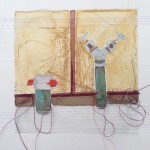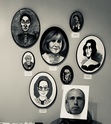Charles Martin's Blog, page 4
March 14, 2016
A Girl Named Winter Part 2
Next chapter of our musical audiobook is up on our or you can listen below:
March 12, 2016
Oklahoma High School Theater Teacher is Chased out of her Job
Something lurks inside our teachers. It simmers inside their posture, their friendly smiles, their diligence. From a distance, nothing appears to be wrong; classes run smoothly and students whine about homework. But step inside a classroom, discard the customary apathy, and look at the teachers themselves. There will be something off kilter. Each spoken word is calculated, each movement controlled; it’s as if our teachers are undercover agents with dangerous secret identities. Our teachers are furious.
Jena Nelson has taught in Oklahoma since 2007. She has devoted herself to introducing students to the theater and training them to be of professional quality. Recently, she has taken on the challenge of directing Stephen Schwartz’s Tony award winning musical Pippin. From the audience, the drama department is a wondrous circus as students in vibrant costumes flip across stage while students in black clothing craft technical feats. In the past four years alone, Nelson’s students have earned $3,527,368 in theatrical scholarships. During the summer of 2012 she took her students to perform at the Edinburgh Fringe Festival and is returning again this summer. The department is skyrocketing. Her salary is plummeting.
Oklahoma is infamous for its education budget cuts. The most recent legislative attack on public education is the proposed voucher program and the removal or requirements to the school district empowerment program. These bills, called SB 609 and SB 1187, have been reviewed by many sources and the Tulsa World goes into detail how Tulsa Public Schools may have to either increase class sizes from 29 to 40 students, cut campus security, restrict transportation, or eliminate extra-curriculars from the school system. (Habib, 2016).
“They’re trying to take public schools and turn them into charter schools,” said Nelson.
An abrupt lack of funding hasn’t been a large concern for Nelson, since arts departments haven’t ever received funding. There is a saying among her department that goes, “we put this show together with a piece of gum and shoestrings.” Take a closer at the sets and you will see the grocery bags, plastic cups, bottle caps, and a myriad of recycled trash that compose the excellent production. Nelson and her students are masters at taking another man’s trash and transforming it into treasure. However, that doesn’t mean the proposed legislation won’t hurt them. Outside of the fall and spring productions, her classroom size is exploding from 20 or so students to 40.
“It means I’m going to have to do more with less” Nelson said. “I have to choose between spending less time with my students for individual coaching and instruction or putting a limit on how many students I bring in. They’re turning me into something I don’t want to be.”
Staying in Oklahoma is not healthy for Nelson. She works an average of 52 hours in the classroom alone on a yearly salary less than $40,000. Outside of the classroom, she spends four weeks a year engaging in technical rehearsal as, countless weekends researching how to improve her teaching, and has to pick up a second job to support her two children. Many of her coworkers have already either left the state and/or the profession of teaching itself. “I feel like I’m going through a divorce,” said Nelson, “and the only reason to stay in the marriage between me and the public school system is the kids.”
Every year, our teachers are reviewed based on the content and standards of their classes. If the majority of their students are passing EOIs, ACTs, AP mock exams, AP exams, chapter tests, pop quizzes, semester exams, and benchmarks in all subjects then they are a passable teacher. Yet, the standardized system of evaluation doesn’t give credit to how many times a teacher talks a student off a ledge or sends a “troubled” student to college or provides lunch and dinner to a student.
“It’s such a slap in the face to everything I do and I believe in,” Nelson said. “This is my calling, this is what I was born to do and this state is trying to run me out of my job by systematically taking away the things I need to do my job.”
Habib, Nour and Andrea Eger. “Putting it into context: What TPS would lose in this budget crisis.” Tulsa World. February 28, 2016. http://www.tulsaworld.com/news/educat...
March 8, 2016
Adventures In Stereo – Audio Book Compositions
Do you like adventure?
Do you like grand musical scores?
Of course you do, which is why Adventures In Stereo is your new favorite thing! Composer Gabriel Gallear and I are collaborating on a series of original stories set to original scores. These are not just normal audio books, but singular pieces where the music and the words are on equal footing. We will also be working with other writers, narrators, and musicians over the course of the year. We are working up to a live production of Orphan and the Dying Lark. So, follow us on Facebook, Soundcloud, ITunes, and other podcast outlets. And it’s FREE!
March 1, 2016
Be Our Neighbor: Studio/Gallery Space In The Paseo Arts District
Literati has relocated to The Paseo Plunge, an old swimming pool being converted into a multi-use art space and we need company. There is a roughly 300 square foot space on the first floor with access directly into the Paseo strip that will be rented out for a temporary time while we wait for a coffee shop to come in(six months). If you are an artist needing a space to work and sell, this is an ideal location. If you are interested in taking a look at the spot, email me at Charles at literatipressok.com or text to 405 315-6224.
Once the coffee shop comes in, we will be opening up many more studio spaces in the back side of the building as well as a bookstore and other goodies. One thing at a time, though.
February 29, 2016
Review of Veins by Drew
The only sensible way to describe Drew is to explain why he is not Charles Bukowski.
1. Though a dread of life permeates Veins, the narrator isn’t defeated by it. He has been doomed by bad parenting, bad schooling, bad genetics, and essentially an entire community that has refused to raise a soft-hearted man completely incapable of raising himself. Motorcycle Dude isn’t beyond resentment, but he refuses to be controlled by it.
2. The artistry in the words is more subtle and way more satisfying. His ability to instill complex ideas into simple phrasing is on display throughout Veins, leading to one of the best closing lines of any book I’ve read in quite a while.
3. Within Veins, you always understand that you are dealing with a character that may be deficient of mind, but not deficient of spirit. This makes the reader’s anguish more pronounced. Hope sustains throughout that things will change for Motorcycle Dude. It seems impossible, but you hope all the same.
4. It makes more sense why the peripheral characters are so flat. With Bukowski, it seems stubborn and close-minded. With Drew, it’s because his character can’t connect with humanity no matter how hard he may try. His myopia isn’t a choice. It’s a curse.
This book reads quickly, almost as a series of loosely linked vignettes rather than a traditional novel, but it can be hard on the soul. Worth it, but be forewarned that you may need something within arms reach to hug onto. More of Drew at toothpastefordinner.com.
February 26, 2016
What The Oscars And The Fast And The Furious Say About Institutional Racism
Last night, I bought a pint of whiskey and queued up Fast and the Furious 7 to amuse myself by live-tweeting my assessment of the Mountain Dew of movie franchises. F&F7 was an adolescent’s fantasy world, just as I assumed it would be. Just as I needed it to be. Tricked out street-racers were parachuted into a foreign country so the top-secret crime-fighting team could take down a tour bus of death. Trying to critically assess a movie that includes any one of those elements is a fool’s errand, but a movie that possesses all those elements? F&F is simply not meant to turn on your brain.
So, yeah, the movie is dumb and I was in a dumb mood so it was perfect for my needs. I was, although, struck by the progressive casting. If you are looking for racial inclusiveness, then the F&F dynasty is a much better fit than anything on the Oscar nominations list. Why is that? Why does this movie with characters as flat as a dragstrip and dialogue composed via a Mad Libs screenwriting workbook do a better job, at least on the surface, of representing the American Melting Pot?
I think the answer may be that F&F is not aimed at the artistic, intellectual elite, but rather the working class who are much more likely to be exposed to a greater array of ethnicities. This is a movie that looks like them and the people they know. This is for the multi-cultural movieplexes, not the monochromatic art house movie theaters. Yes, there is plenty of racially-based typecasting in F&F, but also an earnest attempt to put characters on equal footing regardless of ethnic background. The attempt to equalize the gender balance was a bit more clumsy, but, still, they tried.
I don’t believe it is conscious racism that induces Oscar voters to dismiss movies that reflect non-white culture. I think it is, instead, a natural aspect of being more moved by the familiar. It is easier to identify with someone who looks like you. This is why Santa Claus and Jesus will be presented differently in various cultures. The icon will reflect the people who adore it. If Oscar voters are predominately Caucasian, then they will also gravitate toward stories presenting people who look like them or the people that they know.
As a fellow artistic intellectual, I want to believe that we are above prejudice, but we are not. The Oscar nomination list is a clear example of our failure to overcome racial bias.
To encourage more multi-culturalism in Hollwood, we shouldn’t shame the members of the Academy into voting against their genuine opinions, but rather to shame the institution that does not have a voting pool more reflective of twenty-first century America. To be clear, F&F7 did not deserve an Oscar nomination unless they develop a Most Batshit Insane Stunt Of The Year category, but Chi-Raq did. Spike Lee’s adaptation of the Greek play, Lysistrata was among his most ambitious screenplays. Lee has made a name for following concepts into strange lands, regardless of how the Academy, the critics, or the general populace reacts. Chi-Raq was written in modern verse and explored the culture of gun worship within the black community with a depth, compassion, and courage I’ve not seen anywhere else in film, news media, or online. If the Academy wants to reward innovation and brave storytelling, then this movie qualifies.
So, how do we, as pretentious, artistic elites, begin to make multi-culturalism a reality rather than a vague ideal? Let me tell you a story of my own stumbling moment. I was part of a reading group a couple years back that was focused on one of the great writers of the twentieth century, Ralph Ellison. In the midst of discussions of his opus about the black experience in America, The Invisible Man, we began to consider throwing a literary festival in his honor during Black History Month. During this process, I looked across the table and had the uncomfortable realization that we were just a bunch of white guys segregated from the black community by habit.
Of course, before work began on the actual festival, we did reach out and form important relationships with leaders of the black community and the festival was a success. It has now been adopted by the Ralph Ellison Foundation and a number of important friendships were formed beyond cultural barriers in the process.
But, still, we had to decide to do it. Humans are like that. We get into our herds where we feel most comfortable and allow apathy to separate us from the rest of our beautifully diverse community. How do we start making the casts of our movies start reflecting America? Widen the scope of our herd beyond the narrow definitions of politics, religion, gender, and race. If the Fast and Furious can do it, surely the Academy can too.
February 25, 2016
Exploring The Undertones Of Oklahoma City
Undertones
Showing through March 12th
IAO Gallery
706 W Sheridan Ave in Oklahoma City
individualartists.org
Lisa Jean Allswede’s work is all about learning to accept and, ultimately, love mistakes. Her philosophy behind each piece stems from her unending desire to mix snarls of thread with colorful paintings and whatever else she deems worthy to mirror internal chaos. She teaches her audience that beauty is found in mistakes as well as successes. In her current show at IAO, entitled Undertones, her work examines the beauty found in changing landscapes.
“It’s about paying attention to the environment I’m living in,” Allswede said. Each vignette documents a significant change in the Oklahoma City landscape. Throughout the past year, Allswede investigated the city, photographing the destruction of iconic buildings like the Hotel Black and the construction of parking lots and apartment buildings. Nineteen of the resulting photographs were transformed into dazzling water colors utilizing a concoction developed by Allswede that features hints of silver glittering throughout each piece. Allswede then embellishes the piece with metallic thread using her Husky 900 sewing machine to produce a seductive array of color and depth. Allswede described her art style, “I’m sort of Jackson Pollock meets Milton Avery on the sewing machine.”
The inspiration for this show is rooted in Allswede’s own diverse past. Throughout the years, Allswede has lived in and visited a myriad of different cities, from Florence to Chicago to Pittsburgh. Upon moving to Oklahoma in 2011, she noted OKC’s characteristic humbleness. “People here seem to be apologizing for being Oklahoma,” she said. “We are a good city too. Stop being apologetic.”
You’ve Changed Since the First Time I Saw You exemplifies the themes of both Undertones and Allswede’s work in general. The vignette stars the Devon tower shooting up from the city skyline into a turquoise sky. While the piece may be named after OKC’s tallest building, the foreground is host to a ramshackle bus station. This contrast between industrial shine and characteristic antiquity tells the story of the shift in focus from ghost town to metropolis. The focus on the bus stop and other automotive symbols in the show represent Allswede’s childhood connection to her father who worked in a car factory. Now, the iconic bus station has vanished into the city’s memory and is being replaced with a parking lot to accommodate population growth. The Devon tower still stands.
“When we decided to move to Oklahoma City, the Devon Tower was only half constructed,” said Allswede. “So I came to the city at a time of growth and change, and I noticed that the physical changes in the city were having a social impact,”
While most of the work is host to crystalline blues, a piece titled We’ll Always Be Here uses bright golds and yellows. The subject is two “Y” shaped street pipes standing in front of a store front. Behind each lively drawn pipe, the storefront window reflects a pool of sunshine. Upon showing the work, Allswede’s innate positivity leaked out as she proclaimed, “They look like my friends!” This whimsical aura pervades the entire body of work, allowing the viewer to see Oklahoma City as a wonderland.
In addition to the nineteen vignettes, Allswede plans to display forty-nine more photos through viewfinders hanging from the ceiling. Patrons will be invited to interact directly with these viewfinders, as well as a 24”x36” black and white poster of a bus stop. Art supplies will be provided for patrons to sew and draw on the mural. “I’m inviting participants to color and sew on the image,” said Allswede, “I want them to be part of the change.”
Undertones is a show about growth in demolition and pride in inconsistencies. Allswede brings her fantastical view of Oklahoma City to life with wonky lines and bright dots of unexpected color. It is her way of displaying her pride in OKC and its community.



February 23, 2016
Celebrate Black History
For Black History Month, the Oklahoma City Philharmonic utilized the looser format of their family-focused Discovery concert series to explore music composed by African Americans or inspired by black culture tapped in an ambitious attempt to marry seemingly disparate performance elements with symphonic scores.
And it almost worked.
Featuring performances by rapper Gregory Jerome, RACE Dance Company and actor Michael Andreaus, the Philharmonic explored the black experience within America through the prism of classical music and, though the performance was a bit clumsy, it inspired conversations across the Civic Center about the potential of the multi-discipline project should it be given a bit more room to breathe.
The OKC Philharmonic should absolutely go to this well again, but should expand the idea into a fully imagined production because the best moments of Sunday’s performance of Celebrate Black History where very powerful and even some of the more awkward moments showed a great deal of promise. As proof of concept, the performance worked and should have offered the foundation for something more ambitious.
Here is to hoping that we will see the event not just return next year for Black History Month, but raise the stakes by building the idea into a core addition to the Philharmonic season.
And here are a few thoughts on how to do just that*:
Rather than a general survey of compositions tying directly or loosely into black history, develop a singular theme to tell the history of the African American experience within Oklahoma starting from pre-statehood and going all the way to the present. And it is a riveting story with no shortage of historians to help shape the narrative into a compelling and engaging piece. Don’t let this be a minor, pet project. This is an important story and the Philharmonic could serve as a fascinating platform to educate the community of a story that is far more complex and interesting than most Oklahomans realize.
It is good to expand into more modern music, but when doing so, try a bit harder to reflect the energy and spirit of the music. In the Celebrate Black History production, an instrumental cover of Stevie Wonder’s “Sir Duke” came off sluggish as the symphony rounded the music in the traditional classical style, rather than allowing the music to bounce as originally recorded. Finding a good middle ground will also help future collaborators fit more organically within the concept as opposed to the sometimes clunky moments that happened on Sunday.
More featured musicians. Bringing in African-American performers from the fields of jazz, blues, hip hop, performance art, poetry, and dance should be an element utilized throughout the program. I know this means more work and more money, but this program could serve as wonderful draw to the Philharmonic from outside the core base. That alone is worth the investment, but add to that the increased media interest, not just locally, but nationally.
The Oklahoma City Philharmonic should be applauded for the guts to give this challenging concept a try and there were several moments during the performance that were moving and instructive. This was a great idea that could turn into a powerful production with some investment and further collaboration with the city’s diverse community of professional, African American creatives.
*I know nothing about how to run a symphony or any music organization in general, so take all this with a healthy pinch of salt.



